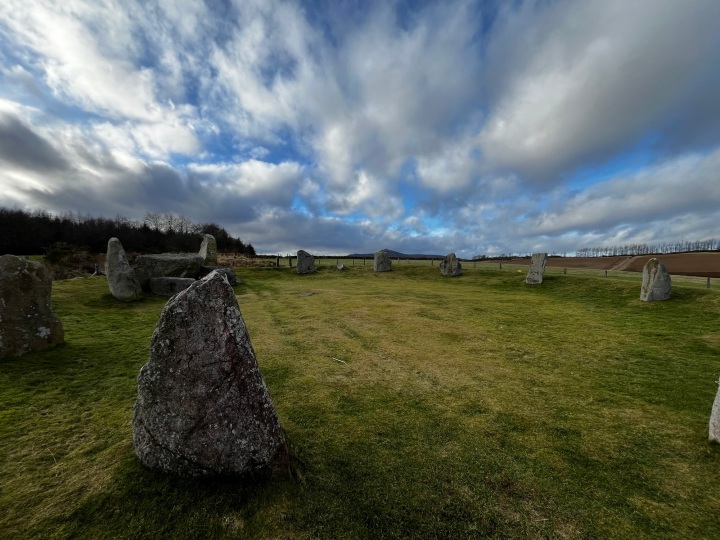
Well folks it’s me again!
What can I say this time to explain yet another absence after my glorious comeback? This time it’s a simple one and a rather sad one. My family and I lost someone exceptionally close to us, my gorgeous Aunty Bev who lost her battle with Motor Neurone Disease. She was one of my biggest supporters and first subscribers, never missing a post. So, after I posted in October and realised she would never see my articles
again I sort of lost my way. However, I am back with her voice in my head telling me to ‘get a move on and post something’ so here we are!

Moving on from the sadness, we are taking a trip to the beautiful Aberdeenshire to discuss the beautiful, enigmatic and atmospheric stone circles that can be found throughout the countryside there. The first stone circle, pictured above, is the ‘East Aquhorthies’ stone circle which is located near Inverurie. Now whilst stone circles can be found throughout the United Kingdom, what makes this monument unique
is that it’s known as a ‘recumbent stone circle’ which are a type of stone circle only found in the north-east of Scotland. The one pictured above is one in around 100 stone circles found in north-eastern Scotland so it truly is a rare and unique find! These circles are called ‘recumbent’ circles due to the large horizontal – recumbent – stone which is laid in the south/south-west arc of the circle.

The East Aquhorthies stone circle was erected roughly around 4,000 years ago and as you can (hopefully) see in the photo comprises of 12 stones in total. There are 11 upright stones, the two closest to the recumbent stone known as the ‘flanker stones.’ We then have the huge recumbent stone in the middle which is the largest in the circle and no doubt the heaviest, estimated to weigh a huge 24 tonnes. The
stones all have a slight pinkish hue except for one on the east side of the circle which is made of red jasper and the varying nature of these stones seems to indicate that they were chosen for their colour! The stone wall around this stone circle was added in the 1800’s to protect the stone circle.

The second stone circle I went to see is the ‘Tomnaverie’ stone circle which is again another recumbent stone circle believed to have been erected around 5,000 years ago. This stone circle is sat at the top of a gorgeous hill with amazing views of surrounding mountains and it is believed that other stone circles would have been visible from this vantage point. If communities could be seen from here, this indicates the widespread nature of communities in this period nearly 5000 years ago! One thing I kept thinking is they must have been cold because my word it was windy and cold up there in January when I went walking and I had a lot of layers on!
However, I am sure you are wondering why these stones are even here?
Well, that is a very good question and sadly, one we don’t have a concrete answer to. We do however have theories regarding them which I will detail below.
The main theory put forward by historians and archaeologists for the existence of these stone circles is that they were used for ritual purposes, used in conjunction with cremation. This theory holds some water as signs of cremation have been found at both stone circles I visited. At the East Aquhorthies stone archaeologists found evidence of burnt stones, charcoal and incinerated bones beneath the cairns. At the Tomnaverie stone circle something similar was found in the 1990’s where an excavation at the centre of the circle unearthed charcoal, burnt soil and bone. This evidence would suggest that rituals pertaining to the dead did in fact take place within these circles and the circles were perhaps built to commemorate the
dead.

Another theory for the existence of stone circles however was that these stones may have been used to help prehistoric communities to follow the changing seasons. The south-west alignment of the stones and the placement of the flanking stones would have framed the rising and setting of the moon. This would indicate that these stones were used by communities to aid them in farming or keeping track of time.
Many have also argued that the Tomnaverie circle in particular has a spiritual connection, framing the mountain of Lochnagar, communities could have erected the stone circle as a way to frame this landscape and provide it with spiritual significance and perhaps it was used as a place of worship.
So that brings us back to the original question of what these stones were used for, and the answer is still ‘we don’t know.’
However, what we do know, besides the fact that cremations took place at the sites, is that these places clearly had significance to communities thousands of years ago and that knowledge alone imbues these places with a sort of mystique and atmosphere that I can’t quite put my finger on. I love going to historic sites and wondering what life was like back then but normally that consists of walking around old castles, Roman forts or old monasteries and while atmospheric, something about these stone circles feels different.
Their isolation geographically but also historically permeates through the stones themselves and you can’t help but look upon them in wonder and marvel at the mystery of how these stone circles came to be and most importantly, why.
This one is dedicated to you Aunty Bev, I know you’d love hearing about all my Scottish adventures- albeit maybe not stone circles! x
